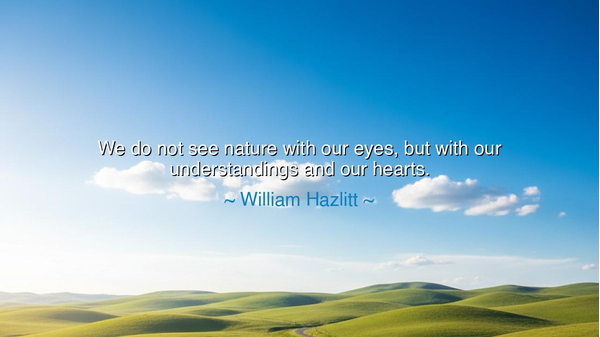
We do not see nature with our eyes, but with our understandings






William Hazlitt once spoke with the voice of a seer: “We do not see nature with our eyes, but with our understandings and our hearts.” These words rise above the commonplace, reminding us that vision is not a matter of sight alone, but of soul. The eyes may behold mountains, rivers, and trees, but unless the inner faculties of the mind and the stirrings of the heart are engaged, the true majesty of nature remains hidden. To perceive rightly is not to scan with organs of flesh, but to interpret with the spirit, to see the invisible truth that dwells within the visible form.
The ancients knew this wisdom well. When the philosopher Heraclitus looked upon a river, he saw more than flowing water — he saw the eternal truth of change, the law that governs all existence. The common passerby, dipping a hand in the stream, saw only water moving over stones. The difference lay not in the eyes, but in the understanding. So too did the Hebrew psalmist gaze upon the heavens and cry: “The heavens declare the glory of God.” The night sky was the same for all men, but to the psalmist it was a cathedral of wonder, because he looked with his heart, not with his eyes alone.
Hazlitt’s words were born in an age when nature was often studied as object — dissected, measured, and classified. Yet he reminds us that the truest encounter with the natural world is not cold analysis, but communion. The eyes may tell us the shape of a leaf, but only the heart can tell us its beauty. The understanding may reveal the laws of the stars, but only the soul can feel awe at their silent grandeur. Thus Hazlitt stands against the reduction of the world to mere data, and calls us to experience it as living, breathing revelation.
History offers us shining examples of this deeper seeing. Consider the life of John Muir, the prophet of the American wilderness. To others, the Sierra Nevada was land to be mined, forests to be felled. But Muir, looking with understanding and heart, saw temples, sanctuaries, and choirs of creation. He wrote not with the cold pen of science alone, but with the fire of reverence. Because he saw truly, he stirred a nation to preserve its wilderness, and thus the spirit of Hazlitt’s words bore fruit in action.
The teaching, then, is this: seeing is not merely perceiving form, but perceiving meaning. Many can stand before a sunset, but only some will feel its call to gratitude, its whisper of eternity. Many can walk through a forest, but only some will recognize it as a living community, not a storehouse of timber. The eyes are instruments, but the heart and understanding are interpreters. Without them, the world remains flat; with them, the world becomes alive with wisdom.
This is a call to awaken our inner faculties. If you would see nature truly, do not pass by hastily, but pause. Ask what the scene before you teaches, what it stirs, what it reveals about your place in the great web of existence. Let your understanding search for truth, but let your heart be moved to wonder. To see in this way is to live more deeply, to walk the earth as a participant rather than a stranger.
Practical steps follow. Spend time in silence beneath the open sky. Watch not only with your eyes, but listen for what your heart whispers. Keep a journal, not of measurements alone, but of feelings, reflections, and insights drawn from the world around you. Teach children not only the names of birds and flowers, but also to love them, to respect them, to hear their silent lessons. In this way, you will train both understanding and heart to see rightly.
Thus Hazlitt’s words endure across the ages: “We do not see nature with our eyes, but with our understandings and our hearts.” Let them be your guide. For if you see only with your eyes, you walk through a pale world of surfaces. But if you see with mind and heart together, you walk through a living temple, where every leaf, every star, every breath of wind proclaims truth eternal.






AAdministratorAdministrator
Welcome, honored guests. Please leave a comment, we will respond soon